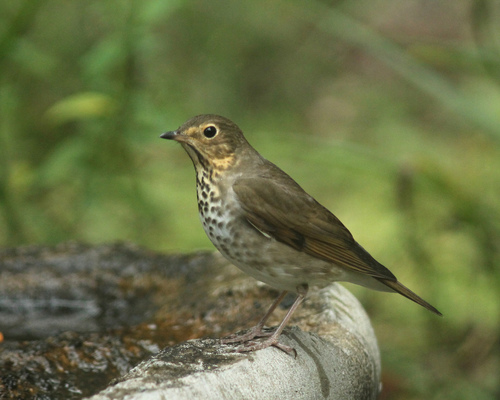
Swainson's Thrush
The Swainson's Thrush (Catharus ustulatus) is a medium-sized songbird renowned for its ethereal, flute-like song that often fills North American forests during the breeding season. This migratory species plays a vital role in seed dispersal and insect control within its ecosystem. While not particularly flashy in appearance, its complex vocalizations and subtle beauty have made it a favorite among birdwatchers. It holds no widely recognized specific cultural significance, but its presence is often associated with healthy, mature forests.
16-20 cm
Length
28-30 cm
Wingspan
Least Concern
Conservation Status
Distribution
Breeds across North America, from Alaska and Canada south to the northern United States and along the Pacific Coast to southern California. Winters in Central and South America, as far south as Argentina. Migratory routes vary, with some populations following the Atlantic or Pacific coastlines, while others cross the Gulf of Mexico.
Lifespan
Up to 10 years in the wild, though the average is likely much shorter. Captivity lifespan is not well documented.
Swainson's Thrush's Habitat
Habitat Types
Coniferous forests, Mixed woodlands, Riparian thickets, Boreal forests
Climate Zones
Temperate, Boreal, Subtropical (during migration and winter)
Adaptations
Prefers dense understory for nesting and foraging, providing cover from predators. Its relatively long wings are adapted for long-distance migration.
Variations
Several subspecies are recognized, differing slightly in plumage and song. For example, the 'olive-backed' subspecies (C. u. ustulatus) is found in the eastern part of its range, while the 'russet-backed' subspecies (C. u. swainsoni) is found in the west.
Appearance
Breeding Plumage
Little to no difference between breeding and non-breeding plumage.
Seasonal Feather Changes
Minimal seasonal variation. Juveniles have spotted plumage that molts into adult plumage within the first year.
Sex Based Plumage Differences
Males and females have nearly identical plumage.
Notable Features
Buffy eye-ring, Buffy-colored breast with dark spots, Olive-brown to reddish-brown upperparts
Diet and Feeding
Primary Foods
Insects, Spiders, Berries, Fruits
Foraging Behavior
Forages primarily on the ground, hopping and gleaning insects and berries from leaf litter and low vegetation. Will also take insects from foliage and occasionally hawk insects in the air.
Specializations
No highly specialized feeding adaptations, but its bill is well-suited for a generalist diet.
Seasonal Diet Variations
Diet shifts seasonally. During the breeding season, insects and other invertebrates are the primary food source. In the fall and winter, berries and fruits become increasingly important, especially during migration and on the wintering grounds.
Behavior
Social Structure
Generally solitary or in pairs during the breeding season. Forms small flocks during migration and on the wintering grounds.
Communication
Complex, flute-like song used for territorial defense and mate attraction., Various call notes, including a sharp 'whit' call and a liquid 'peep' call.
Migration
A long-distance migrant, traveling thousands of miles between breeding and wintering grounds. Migrates at night, using celestial cues and the Earth's magnetic field for navigation.
Territorial or Group Behaviors
Males are territorial during the breeding season, defending their territories with song and aggressive displays. Outside of the breeding season, they are less territorial and may form loose flocks.
Conservation
Threats
Habitat loss and fragmentation (both on breeding and wintering grounds), Collisions with buildings and other structures during migration, Climate change (potentially altering habitat and food availability), Pesticide use (reducing insect prey)
Protection Programs
Monitoring programs (e.g., Breeding Bird Survey), Habitat conservation initiatives (e.g., protection of forests and riparian areas)
Local National Laws
Protected under the Migratory Bird Treaty Act in the United States and Canada.
Population Trend
Stable
Population Estimates
Global population estimated at 40,000,000.
Interesting Facts
They are known for their remarkable ability to navigate during migration.
Studies have shown they use a combination of celestial cues, the Earth's magnetic field, and possibly olfactory cues to find their way.
Their song is one of the most complex and beautiful of North American songbirds.
The song is a series of flute-like phrases that spiral upward in pitch.
They are often difficult to see, despite their distinctive song.
They tend to forage in dense undergrowth and are often more easily heard than seen.
Faqs about Swainson's Thrush
What does a Swainson's Thrush sound like?
Its song is a series of ethereal, flute-like phrases that spiral upward in pitch. It's often described as sounding like 'veer, veer, veer, veer, vee-a, vee-a, vee-a'.
Where can I see a Swainson's Thrush?
During the breeding season, look for them in forests with dense undergrowth. During migration, they can be found in a wider variety of habitats, including parks and gardens.
What is the difference between a Swainson's Thrush and a Hermit Thrush?
Swainson's Thrushes have a buffy eye-ring and buffy-colored breast, while Hermit Thrushes have a bolder white eye-ring and a reddish tail.
Are Swainson's Thrushes endangered?
No, Swainson's Thrushes are currently listed as Least Concern by the IUCN, meaning they are not currently facing a high risk of extinction. However, like many bird species, they face threats from habitat loss and climate change.
Copyright @ Nature Style Limited. All Rights Reserved.
 English
English